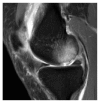Spontaneous Minced Cartilage Procedure for Unexpectedly Large Femoral Condyle Surface Defect
- PMID: 27504207
- PMCID: PMC4967685
- DOI: 10.1155/2016/1498135
Spontaneous Minced Cartilage Procedure for Unexpectedly Large Femoral Condyle Surface Defect
Abstract
Articular cartilage defects at the knee joint are being identified and treated with increasing frequency. Chondrocytes may have strongest potential to generate high-quality repair tissue within the defective region, in particular when large diameter defects are present. Autologous chondrocyte implantation is not available in every country. We present a case where we spontaneously covered an acute cartilage defect, which was significantly larger than expected and loose during initial arthroscopic inspection after reading preoperative MRI, by mincing the separated fragment and directly implanting the autologous cartilage chips into the defective region.
Figures



Similar articles
-
Second-Generation Autologous Minced Cartilage Repair Technique.Arthrosc Tech. 2017 Jan 30;6(1):e127-e131. doi: 10.1016/j.eats.2016.09.011. eCollection 2017 Feb. Arthrosc Tech. 2017. PMID: 28373950 Free PMC article.
-
Nasal chondrocyte-based engineered autologous cartilage tissue for repair of articular cartilage defects: an observational first-in-human trial.Lancet. 2016 Oct 22;388(10055):1985-1994. doi: 10.1016/S0140-6736(16)31658-0. Lancet. 2016. PMID: 27789021
-
Repair of an Osteochondral Defect With Minced Cartilage Embedded in Atelocollagen Gel: A Rabbit Model.Am J Sports Med. 2019 Jul;47(9):2216-2224. doi: 10.1177/0363546519854372. Epub 2019 Jun 17. Am J Sports Med. 2019. PMID: 31206306
-
[Cartilage repair of the knee joint].Orthopade. 2017 Nov;46(11):919-927. doi: 10.1007/s00132-017-3463-x. Orthopade. 2017. PMID: 28852793 Review. German.
-
Autologous tissue transplantations for osteochondral repair.Dan Med J. 2016 Apr;63(4):B5236. Dan Med J. 2016. PMID: 27034191 Review.
Cited by
-
Minced Autologous Chondral Fragments with Fibrin Glue as a Simple Promising One-Step Cartilage Repair Procedure: A Clinical and MRI Study at 12-Month Follow-Up.Cartilage. 2022 Dec;13(4):19-31. doi: 10.1177/19476035221126343. Epub 2022 Oct 28. Cartilage. 2022. PMID: 36305343 Free PMC article.
-
One-Step Autologous Minced Cartilage Procedure for the Treatment of Knee Joint Chondral and Osteochondral Lesions: A Series of 27 Patients With 2-Year Follow-up.Orthop J Sports Med. 2019 Jun 13;7(6):2325967119853773. doi: 10.1177/2325967119853773. eCollection 2019 Jun. Orthop J Sports Med. 2019. PMID: 31223628 Free PMC article.
-
Second-Generation Autologous Minced Cartilage Repair Technique.Arthrosc Tech. 2017 Jan 30;6(1):e127-e131. doi: 10.1016/j.eats.2016.09.011. eCollection 2017 Feb. Arthrosc Tech. 2017. PMID: 28373950 Free PMC article.
-
One-stage minced cartilage autograft with platelet-rich plasma improves early clinical outcomes: A multicentric retrospective study.J Exp Orthop. 2025 Feb 10;12(1):e70162. doi: 10.1002/jeo2.70162. eCollection 2025 Jan. J Exp Orthop. 2025. PMID: 39931147 Free PMC article.
-
Autologous platelet-rich plasma and fibrin-augmented minced cartilage implantation in chondral lesions of the knee leads to good clinical and radiological outcomes after more than 12 months: A retrospective cohort study of 71 patients.J Exp Orthop. 2024 Oct 16;11(4):e70051. doi: 10.1002/jeo2.70051. eCollection 2024 Oct. J Exp Orthop. 2024. PMID: 39415804 Free PMC article.
References
-
- Marlovits S., Singer P., Zeller P., Mandl I., Haller J., Trattnig S. Magnetic resonance observation of cartilage repair tissue (MOCART) for the evaluation of autologous chondrocyte transplantation: determination of interobserver variability and correlation to clinical outcome after 2 years. European Journal of Radiology. 2006;57(1):16–23. doi: 10.1016/j.ejrad.2005.08.007. - DOI - PubMed
LinkOut - more resources
Full Text Sources
Other Literature Sources

